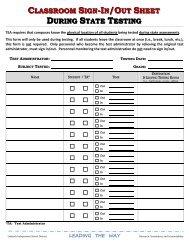Guidelines for Co-Teaching in Texas - Region 17
Guidelines for Co-Teaching in Texas - Region 17
Guidelines for Co-Teaching in Texas - Region 17
Create successful ePaper yourself
Turn your PDF publications into a flip-book with our unique Google optimized e-Paper software.
Figure 15: <strong>Co</strong>-<strong>Teach<strong>in</strong>g</strong>: Tips <strong>for</strong> Start<strong>in</strong>g Off on the Right FootEffective co-teachers comb<strong>in</strong>e several elements: a shared, unwaver<strong>in</strong>gbelief that a teacher’s primary responsibility is to help every studentsucceed; knowledge and skills <strong>for</strong> effectively teach<strong>in</strong>g diverse learners;recognition that two teachers, with different but respected po<strong>in</strong>ts of view,can generate more ideas <strong>for</strong> reach<strong>in</strong>g students than a teacher work<strong>in</strong>galone; and a commitment to success that blends flexibility and a sense ofhumor with a strong allegiance to the partnership. Of course, it takes timeto develop exemplary co-teach<strong>in</strong>g, and the first step is beg<strong>in</strong>n<strong>in</strong>g the schoolyear on a positive note. Here are suggestions <strong>for</strong> do<strong>in</strong>g just that:• As soon as you learn who your co-teach<strong>in</strong>g partner will be, reach out to that <strong>in</strong>dividual,suggest<strong>in</strong>g a meet<strong>in</strong>g prior to the start of the school year, even if that option has not<strong>for</strong>mally been arranged by your adm<strong>in</strong>istrator.• Be<strong>for</strong>e teach<strong>in</strong>g, discuss what each of you considers non-negotiables—those beliefsthat are most important to you as a teacher. If some of the items conflict (e.g., generaleducator believes she should deliver all curriculum but special educator disagrees;special educator believes he should work exclusively with students with disabilitiesbut general educator disagrees), it is important to reach an agreement be<strong>for</strong>e fac<strong>in</strong>gstudents. Be sure to address <strong>in</strong>struction and behavior/classroom management.• Discuss how <strong>in</strong>troductions will be handled on the first day with students. How will it becommunicated to students that you have parity <strong>in</strong> the classroom, even if one of you isnot there at all times?• Create a relatively detailed lesson plan <strong>for</strong> the first day with students, one that<strong>in</strong>cludes group<strong>in</strong>g students and has both teachers assum<strong>in</strong>g an active teach<strong>in</strong>g role.• Plan out the first week of lessons, extend<strong>in</strong>g the conversation about the first day togroup<strong>in</strong>g strategies and teach<strong>in</strong>g responsibilities.• Discuss several “what ifs:” What if one of us makes a mistake dur<strong>in</strong>g teach<strong>in</strong>g? Whatif one of us is concerned about someth<strong>in</strong>g the other person says to students? What ifone of us dislikes the way a particular <strong>in</strong>structional or behavioral issue was addresseddur<strong>in</strong>g class?• Beg<strong>in</strong> a conversation on other important matters <strong>in</strong>clud<strong>in</strong>g grad<strong>in</strong>g student work, thesystem <strong>for</strong> evaluat<strong>in</strong>g the work of students with disabilities (e.g., avoid<strong>in</strong>g a gradepenalty when accommodations are made), report card grades, options both of you (orone or neither) are com<strong>for</strong>table with <strong>for</strong> accommodat<strong>in</strong>g diverse student needs.• Discuss teach<strong>in</strong>g chores and how they will get done (e.g., duplicat<strong>in</strong>g, lab set-up).• Set up several times dur<strong>in</strong>g the first month of school when you will touch baseregard<strong>in</strong>g <strong>in</strong>struction, behavior, and your partnership.• Spend a few m<strong>in</strong>utes gett<strong>in</strong>g to know each other as professionals and people—it willhelp the process of becom<strong>in</strong>g com<strong>for</strong>table as teach<strong>in</strong>g partners!© <strong>Texas</strong> Education Agency / Education Service Center, <strong>Region</strong> 20 <strong>Texas</strong> <strong>Co</strong>-<strong>Teach<strong>in</strong>g</strong> <strong>Guidel<strong>in</strong>es</strong> | 43
















